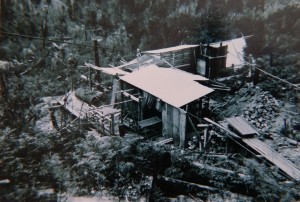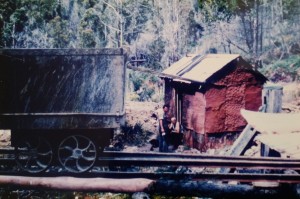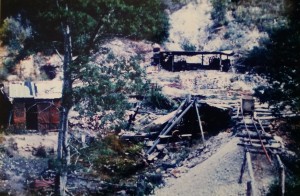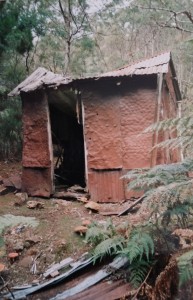Hedley Higgs’ home-made gold mine

Hedley Higgs at his Narrawa Creek gold mine. No, he’s not cross dressing … that’s a metalworking apron. Photo courtesy of Sheila Slowan.
For many people the Wall Street crash of 1929 heralded an era of making do with very little. Some families still earned a crust on the mining fields. In 1931 the pound was devalued, causing a spike in the fixed price of gold.[1] Wallets sprang open like blooms in a drought-breaking downpour. On the small Middlesex mining field in north-western Tasmania new money was pumped into the old Great Caledonian gold mine. William Aylett made grand claims for the old Lea River gold mine.[2] Two-hundred-and-twenty acres were taken up on Black Bluff to work the old Devonport Prospecting Association gold mine.[3] Fossicking near the old Narrawa Creek gold mine in August 1934, Devonport mechanic Hedley Higgs (1885–1980) found extremely find gold in the roots of an upturned tree.[4]
Higgs was an engineering prodigy. He had the same love of gadgets, bikes and engines that characterised his Launceston contemporaries such as Stephen Spurling III, HJ King and Fred Smithies. However, unlike them, he did not take up photography. The Higgs family were well-known shipbuilders at the Mersey River, and Hedley was a skilled yacht builder and yachtsman. He was also an expert marksman. As a young man he zipped about on a Harley Davidson, managed his own motor garage and fixed motorbikes for the self-proclaimed Launceston ‘bike king’ Sim King.[5] The grandson of the Tasmanian amateur scientist AB Biggs, Higgs had repaired radios, tried to patent an explosive and blown himself up with acetylene gas by the time he got to the mining game.[6] He knew nothing about mineral processing until he was asked to build a plant for the Stormont bismuth mine in the early 1930s. Of course his plant was a success, but the mine was forced to close when the Iris River bridge was burnt out.[7]
Now Higgs started forking the Narrawa Creek gravel through sluice boxes. His journal entries demonstrate that mining was sometimes hazardous: ‘Lost ½ plug of gelignite warned men’.[8] Gold recovery was testing: ‘Finished cleaning up for a little under 4 oz. Gold looks clean and has a lot of larger pieces in it. Paddock worked in hollow below pines on race, amount sluiced about 110 yards but a lot of gold left on the bottom!’[9] Ingenuity was always required: ‘brought back old sterilizer from Devon Hospital …’[10]
Then in 1935 Higgs rigged up a battery to crush the ore. Old Ford car axles became rods for the stamper battery. Even a bicycle was introduced to the works.[11] The machinery was driven by a seven-horsepower oil engine.[12] However, he still needed water for sluicing, and the weather did him few favours. Summer offered little rain, in winter it snowed.[13] Nor were the natives necessarily helpful or friendly. In March 1936 Higgs collided with two men riding a motorbike, damaging his car. ‘Reported accident to police’, he noted, ‘renewed permit to carry pistol …’[14] In the following year, one of his employees at the mine, Harry Lawson, was shot dead in a dispute over hunting territory.[15] Another, Dick Nichols, had a shot fired into his house after taking up with another man’s wife.[16]
Early sluice box and battery clean-ups were promising. By 1937 the mine had produced 188.5 oz of gold from the treatment of 1118 tons of ore.[17] Higgs drove an adit to cut the lode at greater depth, but when the oxidised zone gave way to sulphide ores, he was left with hard galena and pyrite.[18]
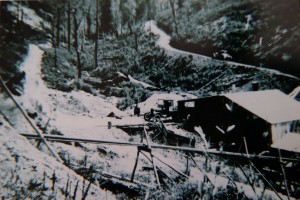
In the late 1930s the Public Works Department built a road down to the mine. Photo courtesy of Sheila Slowan.
When World War II started, the price of tungsten, used for hardening steel in munitions, soared, and Higgs turned his attention to the adjacent Squib tungsten and molybdenum mine, last worked when prices were high at the end of World War I. Everything went well until payday came at Christmas—and the mainland company had only £20 in the kitty.[19] Hedley Higgs’ brief flirtation with mining was over.
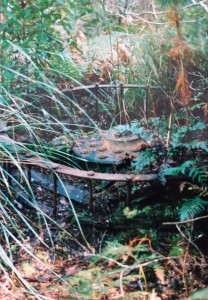
Metal wheel at the Higgs/Sunrise mine site in 1993. In his archaeological report, Parry Kostoglou suggests this could be part of an ore disintegrator.
But the Higgs gold mine was not dead. It was worked as the Sunrise mine in the 1960s by Keith Harvey and Arthur Goldworthy, the latter being a member of an old Cornish family who had come to Moina via the Moonta copper mine in South Australia’s ‘Little Cornwall’ and the Beaconsfield gold mine. Inevitably, it was reworked yet again during gold’s upward parabola after the US government placed the precious metal on the open market, churning up any evidence of Hedley Higgs’ home-grown gold plant.
[1] Geoffrey Blainey, The rush that never ended: a history of Australian mining, 5th edn, Melbourne University Press, 2003, p.307.
[2] See Simon Cubit and Nic Haygarth, Mountain men: stories from the Tasmanian high country, Forty South Publishing, Hobart, 2015, pp.52–53.
[3] ‘Middlesex gold: mainland company interested’, Advocate, 7 November 1936, p.10.
[4] Interview with Sheila Slowan, daughter of Hedley Higgs, East Devonport, c1993.
[5] Motor vehicle registrations, Police Gazette, 10 December 1920, p.237.
[6] Devon News, 20 August 1964 (newspaper clipping obtained from Sheila Slowan).
[7] Devon News, 20 August 1964 (newspaper clipping obtained from Sheila Slowan).
[8] Hedley Higgs journal entry, 9 February 1935, courtesy of Sheila Slowan.
[9] Hedley Higgs journal entries, 23 and 23 May 1935, courtesy of Sheila Slowan.
[10] Hedley Higgs journal entry, 9 March 1936, courtesy of Sheila Slowan.
[11] Interview with Sheila Slowan, daughter of Hedley Higgs, East Devonport, c1993.
[12] ‘Unique battery at Middlesex’, Examiner, 16 January 1936, p.8.
[13] Hedley Higgs journal entries, 27 January 1935 and 13 June 1936, courtesy of Sheila Slowan.
[14] Hedley Higgs journal entries, 8 and 9 March 1936, courtesy of Sheila Slowan.
[15] See ‘Twelve witnesses examined …’, Advocate, 11 May 1937
[16] Higgs alluded to this well-known incident in an interview with Kerry Pink, ‘A couple of “old timers” with no time for idleness’, Advocate story, details unknown. Nichols was listed as employee in Higgs’ journal, held by Sheila Slowan.
[17] F Blake, ‘Higgs’ gold mine—Narrawa Creek’, Unpublished Department of Mines report, 1937; cited by AE (Tony) Webster, An archaeological survey of the Higgs gold mine, near Moina, north-western Tasmania, Mining Geoscience, 1998, p.5.
[18] ‘Middlesex fields’, Mercury, 8 July 1936, p.4.
[19] Kerry Pink, ‘A couple of “old timers” with no time for idleness’, Advocate story, details unknown.


